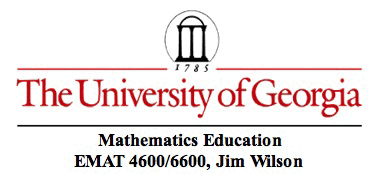

Hint: Use the Arithmetic Mean-Geometric Mean Inequality to find the maximum area of a circular sector with a fixed perimeter.
Understanding the problem. A sector of a circle has a perimeter made up of two radii and an arc of the circle connecting the endpoints of the two radii. Compare the areas of three sectors -- each with P = 100 -- central angles of 45 degrees, 90 degrees, and 180 degrees. These are sectors that are an eighth circle, quarter circle, and semicircle. As the angles increas, the radii become shorter because more of the fixed perimeter is in the arc. Note these angles are
When these three areas are computed we get
Clearly, as the angle increases from 45 to 90 to 180 the area increases and then decreases. Somewhere there is a maximum area. Where?
Sector as Fraction of a Circle
Some students (and teachers) have an aversion to working with radian measure. For them the approach might be as follows:
Let k be the fraction of a circle represented by the sector. 0 < k < 1. The Perimeter is a constant and so we can represent it as twice the radius plus the fraction of the circumference.
The area of the sector in the fraction notation can be formed as either a function of r or a function of k, depending on a subsitution of r or k from the perimeter equation. Either one can be used with the AM-GM Inequality to reach closure on the problem:
Looking back at the example when P = 100, the maximum area would be when r = 25 and therefore the arc length is 50. The angle is a little less than 120 degrees.
Sector in Radian Measure
The parallel of this solution with the one where the square was the maximum area for rectangles with fixed perimeter is worth noting.